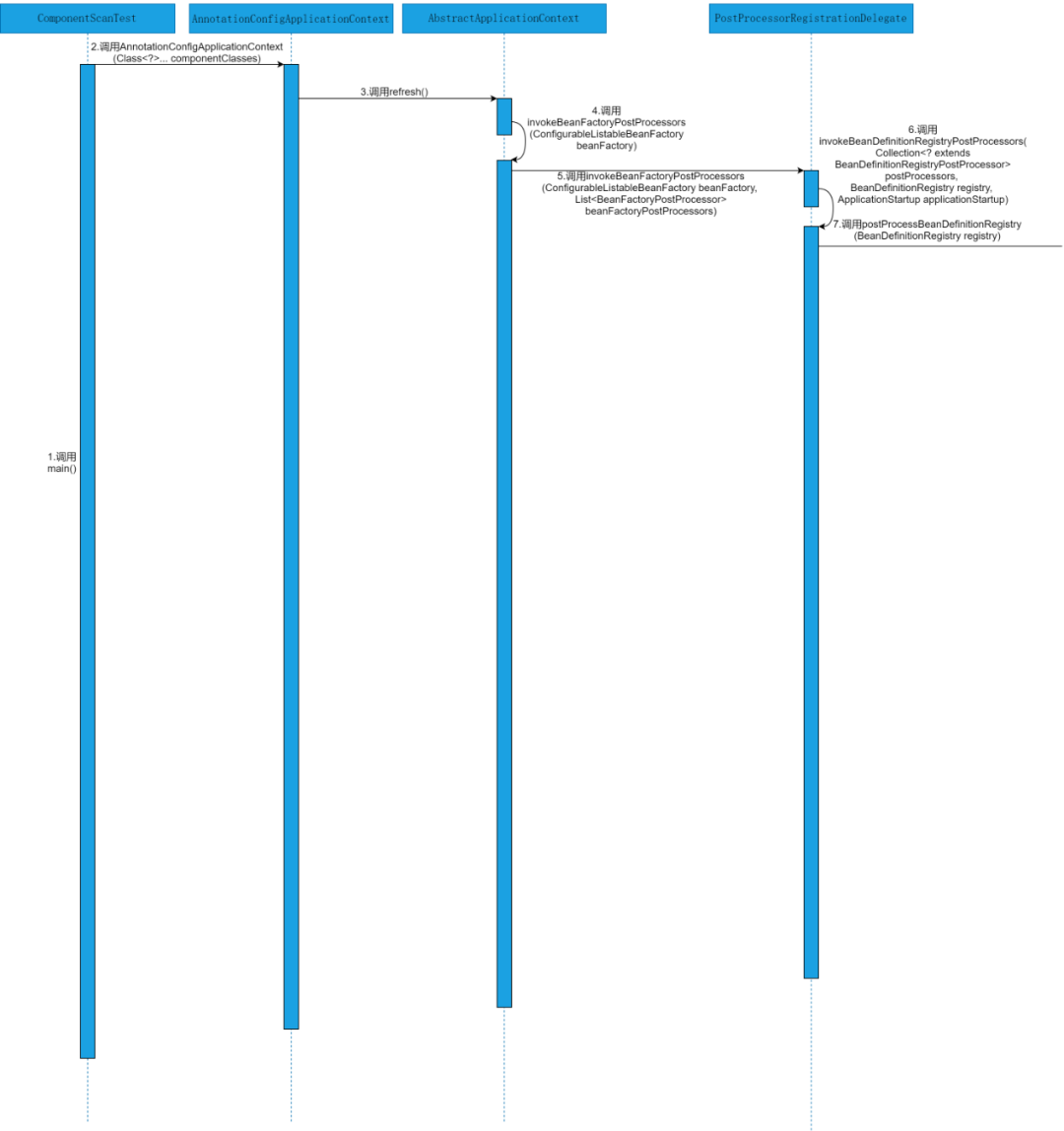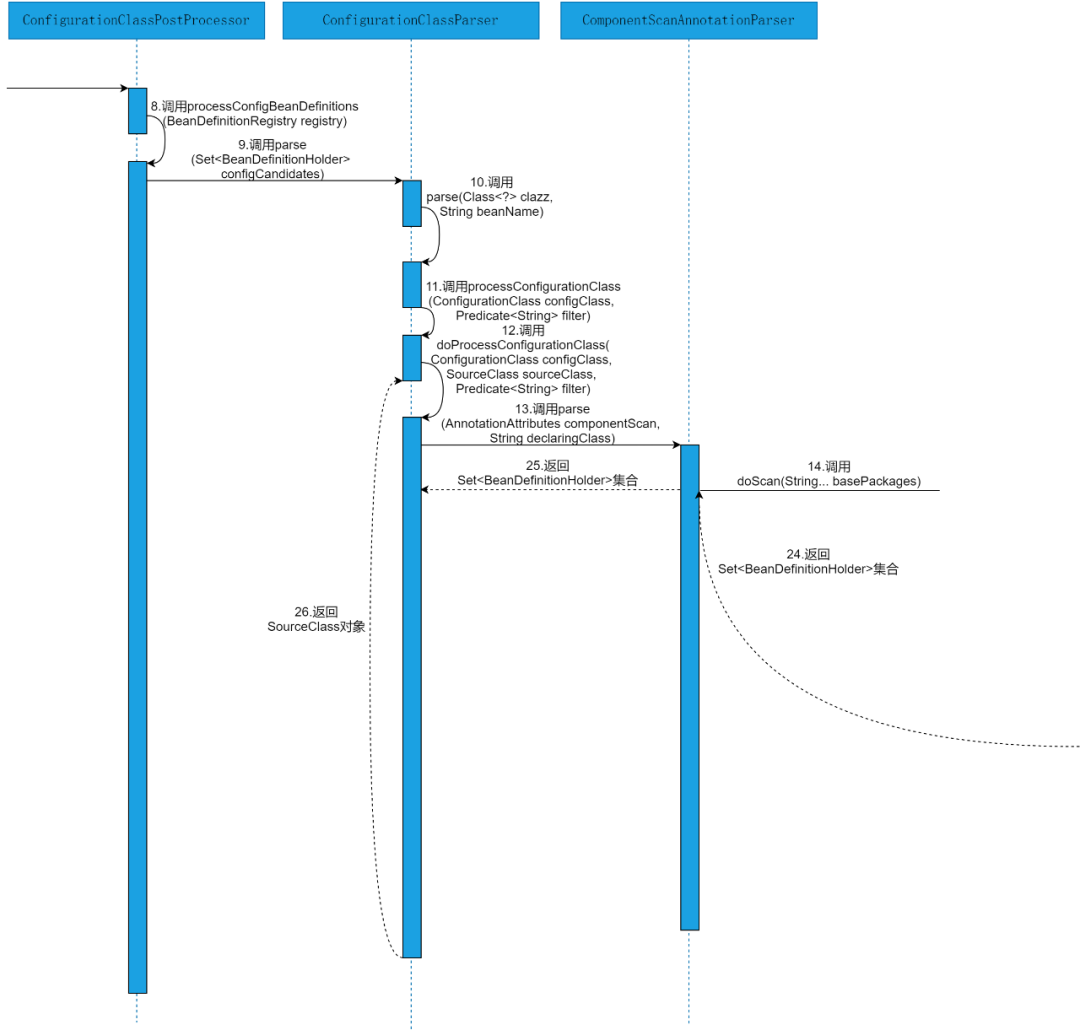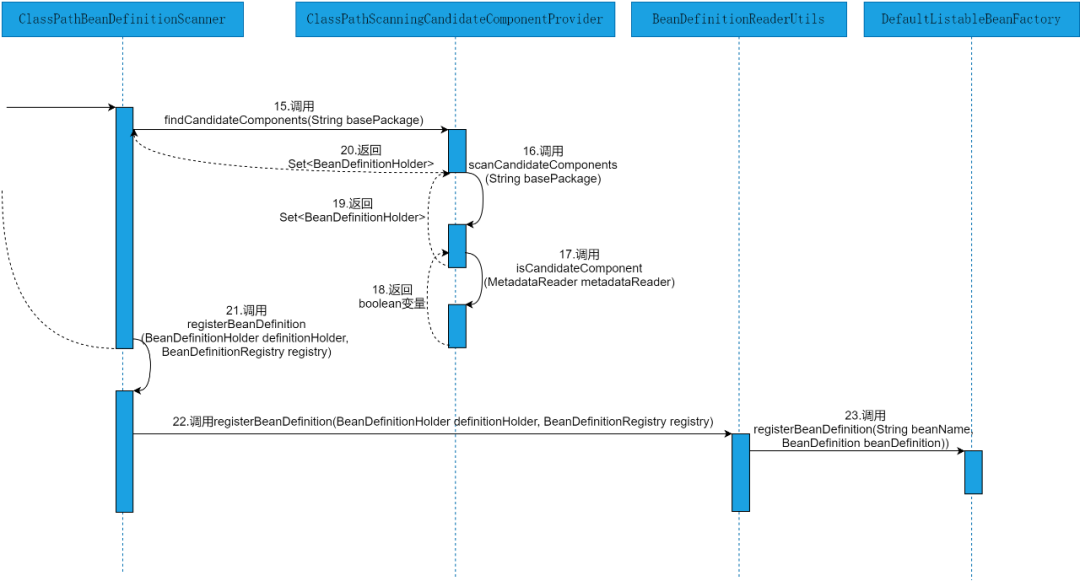《Spring核心技术》@ComponentScan注解(上)
一、学习指引
想成为秃顶的资深工程师,关于@ComponentScans注解与@ComponentScan注解,不能只停留在表面!
翻开Spring的源码找到@ComponentScan注解的源码,发现注解类上赫然标注着Since: 3.1字样。也就是说,@ComponentScan注解是从Spring的3.1版本开始提供的。在@ComponentScan注解上,标注了一个@Repeatable注解,@Repeatable注解的属性值为ComponentScans.class。再次翻看下@ComponentScans注解的源码,类上标注着Since: 4.3字样。也就是说,@ComponentScans注解是从Spring4.3版本开始提供的。@ComponentScans注解就相当于是@ComponentScan注解的一个数组,在@ComponentScans注解中可以多次使用@ComponentScan注解来扫描不同的包路径。
如果你只想做一个天天加班的CRUD的程序员,掌握上述的基本知识就够了。CRUD操作不需要你对@ComponentScans注解与@ComponentScan注解有多么深入的了解。但是,如果你想对Spring的源码有进一步的了解和认识,想熟悉Spring核心源码的执行流程,想成为一名合格的架构师或技术专家,只了解上述@ComponentScans注解与@ComponentScan注解最基本的知识点是远远不够的。
二、注解说明
@ComponentScans注解与@ComponentScan注解的一点点说明!
@ComponentScans注解可以看作是@ComponentScan注解的一个数组,在@ComponentScans注解中可以多次标注@ComponentScan注解。
@ComponentScan注解最核心的功能就是Spring IOC容器在刷新的时候会扫描对应包下标注了@Component注解、@Configuration注解、@Repository注解、@Service注解和@Controller等等注解的类,生成扫描到的类的Bean定义信息,整体流程与注册ConfigurationClassPostProcessor类的Bean定义信息的流程基本一致,最终都会将其保存到BeanFactory中的beanDefinitionMap中。
2.1 注解源码
本节,主要是对@ComponentScans注解和@ComponentScan注解的源码进行简单的剖析。
2.1.1 @ComponentScans注解源码
源码详见:org.springframework.context.annotation.ComponentScans,如下所示。
/***
* @author Juergen Hoeller
* @since 4.3
* @see ComponentScan
*/
@Retention(RetentionPolicy.RUNTIME)
@Target(ElementType.TYPE)
@Documented
public @interface ComponentScans {
ComponentScan[] value();
}可以看到,@ComponentScans注解的源码还是比较简单的,在@ComponentScans注解中存在一个ComponentScan[]数组类型的value属性,说明@ComponentScans注解的属性可以存放一个@ComponentScan注解类型的数组,可以在ComponentScans注解中多次添加@ComponentScan注解。从@ComponentScans注解的源码还可以看出,@ComponentScans注解从Spring 4.3版本开始提供。
2.1.2 @ComponentScan注解源码
@ComponentScan注解的源码是本章分析的重点内容,@ComponentScan注解的源码详见:org.springframework.context.annotation.ComponentScan,如下所示。
/*
* @author Chris Beams
* @author Juergen Hoeller
* @author Sam Brannen
* @since 3.1
* @see Configuration
*/
@Retention(RetentionPolicy.RUNTIME)
@Target(ElementType.TYPE)
@Documented
@Repeatable(ComponentScans.class)
public @interface ComponentScan {
@AliasFor("basePackages")
String[] value() default {};
@AliasFor("value")
String[] basePackages() default {};
Class<?>[] basePackageClasses() default {};
Class<? extends BeanNameGenerator> nameGenerator() default BeanNameGenerator.class;
Class<? extends ScopeMetadataResolver> scopeResolver() default AnnotationScopeMetadataResolver.class;
ScopedProxyMode scopedProxy() default ScopedProxyMode.DEFAULT;
String resourcePattern() default ClassPathScanningCandidateComponentProvider.DEFAULT_RESOURCE_PATTERN;
boolean useDefaultFilters() default true;
Filter[] includeFilters() default {};
Filter[] excludeFilters() default {};
boolean lazyInit() default false;
@Retention(RetentionPolicy.RUNTIME)
@Target({})
@interface Filter {
FilterType type() default FilterType.ANNOTATION;
@AliasFor("classes")
Class<?>[] value() default {};
@AliasFor("value")
Class<?>[] classes() default {};
String[] pattern() default {};
}
}可以看到,Spring从3.1版本开始提供@ComponentScan注解,@ComponentScan注解中还有一个内部注解@Filter。
@ComponentScan注解中的每个属性的含义如下所示。
- value:作用同basePackages属性,String[]数组类型,指定要扫描的包名。如果指定了要扫描的包名,则Spring会扫描指定的包及其子包下的所有类。
- basePackages:作用同value属性,String[]数组类型,指定要扫描的包名。如果指定了要扫描的包名,则Spring会扫描指定的包及其子包下的所有类。
- basePackageClasses:Class<?>[]数组类型,指定要扫描的类的Class对象。
- nameGenerator:Class<? extends BeanNameGenerator>类型,指定扫描类时,向IOC注入Bean对象时的命名规则。
- scopeResolver:Class<? extends ScopeMetadataResolver>类型,扫描类时,用于处理并转换符合条件的Bean的作用范围。
- scopedProxy:ScopedProxyMode类型,指定生成Bean对象时的代理方式,默认的代理方法是DEFAULT,也就是不使用代理。关于ScopedProxyMode的更多详细的内容,参见2.1.3节。
- resourcePattern:String类型,用于指定扫描的文件类型,默认是扫描指定包下的
**/*.class。 - useDefaultFilters:boolean类型,是否自动检测@Component @Repository @Service @Controller注解,默认是true。
- includeFilters:Filter[]数组类型,自定义组件扫描过滤规则,符合过滤规则的类的Bean定义信息会被注册到IOC容器中。includeFilters表示只包含对应的规则,当使用includeFilters()来指定只包含哪些注解标注的类时,需要禁用默认的过滤规则,也就是需要将useDefaultFilters属性设置为false。并且,除了符合过滤规则的类外,Spring内置的如下名称的类的Bean定义信息注册到IOC容器时不受过滤规则限制,如下所示。
org.springframework.context.annotation.internalConfigurationAnnotationProcessor
org.springframework.context.annotation.internalAutowiredAnnotationProcessor
org.springframework.context.event.internalEventListenerProcessor
org.springframework.context.event.internalEventListenerFactory- excludeFilters:Filter[]数组类型,自定义组件扫描过滤规则,excludeFilters表示排除使用对应的规则,符合过滤规则的类的Bean定义信息不会被注册到IOC容器中。
- lazyInit:boolean类型,从Spring4.1版本开始提供,表示Spring扫描组件时是否采用懒加载 ,默认false,表示不开启懒加载。
@Filter注解中的每个属性的含义如下所示。
- type:FilterType类型,表示过滤规则的类型。关于FilterType的更多详细的内容,参见2.1.4节。
- value:Class<?>[]数组类型,过滤符合规则的类,作用同classes属性。
- classes:Class<?>[]数组类型,过滤符合规则的类,作用同value属性。
- pattern:如果FilterType取值为ASPECTJ,则此属性表示ASPECTJ表达式。
2.1.3 ScopedProxyMode枚举类源码
ScopedProxyMode枚举类表示Spring指定生成Bean对象时的代理方式,源码详见:org.springframework.context.annotation.ScopedProxyMode。
/*
* @author Mark Fisher
* @since 2.5
* @see ScopeMetadata
*/
public enum ScopedProxyMode {
DEFAULT,
NO,
INTERFACES,
TARGET_CLASS
}ScopedProxyMode类是从Spring 2.5版本开始提供的枚举类,每个属性的含义如下所示。
- DEFAULT:默认的代理方式,也就是不使用代理,除非在component-scan级别使用了不同的配置。
- NO:不使用代理。
- INTERFACES:基于JDK动态代理实现接口代理对象。
- TARGET_CLASS:基于CGLib动态代理创建类代理对象。
2.1.4 FilterType枚举类源码
FilterType枚举类表示Spring扫描类时的过滤类型,源码详见:org.springframework.context.annotation.FilterType,如下所示。
/*
* @author Mark Fisher
* @author Juergen Hoeller
* @author Chris Beams
* @since 2.5
*/
public enum FilterType {
ANNOTATION,
ASSIGNABLE_TYPE,
ASPECTJ,
REGEX,
CUSTOM
}FilterType类是Spring2.5版本开始提供的枚举类,每个属性的含义如下所示。
- ANNOTATION:按照注解进行过滤。
- ASSIGNABLE_TYPE:按照给定的类型进行过滤。
- ASPECTJ:按照ASPECTJ表达式进行过滤。
- REGEX:按照正则表达式进行过滤。
- CUSTOM:按照自定义规则进行过滤,使用自定义过滤规则时,自定义的过滤器需要实现org.springframework.core.type.filter.TypeFilter接口。
在FilterType枚举类中,ANNOTATION和ASSIGNABLE_TYPE是比较常用的,ASPECTJ和REGEX不太常用,如果FilterType枚举类中的类型无法满足日常开发需求时,可以通过实现org.springframework.core.type.filter.TypeFilter接口来自定义过滤规则,此时,将@Filter中的type属性设置为FilterType.CUSTOM,classes属性设置为自定义规则的类对应的Class对象。
2.2 注解使用场景
使用Spring的注解开发应用程序时,如果需要将标注了Spring注解的类注入到IOC容器中,就需要使用@ComponentScan注解来扫描指定包下的类。同时,在Spring4.3版本开始,提供了@ComponentScans注解,在@ComponentScans注解中,支持配置多个@ComponentScan注解来扫描不同的包,配置不同的过滤规则。
三、使用案例
整个案例来玩玩儿吧!
3.1 案例描述
使用自定义过滤规则实现Spring扫描指定包下的类时,使得名称中含有 componentScanConfig 字符串的类符合过滤规则。
3.2 案例实现
整个案例实现的步骤总体如下所示。
(1)新建自定义过滤规则类ComponentScanFilter
ComponentScanFilter类的源码详见:spring-annotation-chapter-02工程下的io.binghe.spring.annotation.chapter02.componentscan.filter.ComponentScanFilter,如下所示。
public class ComponentScanFilter implements TypeFilter {
@Override
public boolean match(MetadataReader metadataReader, MetadataReaderFactory metadataReaderFactory) throws IOException {
//获取当前正在扫描的类的信息
ClassMetadata classMetadata = metadataReader.getClassMetadata();
//获取当前正在扫描的类名
String className = classMetadata.getClassName();
return className.contains("componentScanConfig");
}
}可以看到,自定义过滤规则ComponentScanFilter类实现了TypeFilter接口,并覆写了match()方法,match()方法中的核心逻辑就是:如果类的名称中含有componentScanConfig字符串,符合过滤规则,返回true,否则,返回false。
(2)新建配置类ComponentScanConfig
ComponentScanConfig类的源码详见:spring-annotation-chapter-02工程下的io.binghe.spring.annotation.chapter02.componentscan.config.ComponentScanConfig,如下所示。
@Configuration
@ComponentScan(value = "io.binghe.spring.annotation.chapter02", includeFilters = {
@Filter(type = FilterType.CUSTOM, classes = {ComponentScanFilter.class})
}, useDefaultFilters = false)
public class ComponentScanConfig {
}可以看到,在ComponentScanConfig类上标注了@Configuration注解,说明ComponentScanConfig类是Spring的配置类。在标注的@ComponentScan注解中指定了要扫描的包名,使用只包含的过滤规则,并采用自定义过滤规则。
此时,需要注意的是,需要将是否使用默认的过滤规则设置为false。
(3)新建测试类ComponentScanTest
ComponentScanTest类的源码详见:spring-annotation-chapter-02工程下的io.binghe.spring.annotation.chapter02.componentscan.ComponentScanTest,如下所示。
public class ComponentScanTest {
public static void main(String[] args) {
AnnotationConfigApplicationContext context = new AnnotationConfigApplicationContext(ComponentScanConfig.class);
String[] names = context.getBeanDefinitionNames();
Arrays.stream(names).forEach(System.out::println);
}
}可以看到,在ComponentScanTest类中,在AnnotationConfigApplicationContext类的构造方法中传入ComponentScanConfig类的Class对象创建IOC容器,并将其赋值给context局部变量。通过context局部变量的getBeanDefinitionNames()方法获取所有的Bean定义名称,随后遍历这些Bean定义名称进行打印。
3.3 案例测试
本案例中,在@ComponentScan注解中使用了includeFilters过滤规则,并且使用的是自定义过滤规则,符合过滤规则的是名称中含有 componentScanConfig 字符串的类。另外,Spring中内置的Processor类和Factory类的Bean定义信息注册到IOC容器时,不受过滤规则限制。
运行ComponentScanTest类输出的结果信息如下所示。
org.springframework.context.annotation.internalConfigurationAnnotationProcessor
org.springframework.context.annotation.internalAutowiredAnnotationProcessor
org.springframework.context.event.internalEventListenerProcessor
org.springframework.context.event.internalEventListenerFactory
componentScanConfig可以看到,从IOC容器中获取的Bean的类定义信息的名称中可以看出,除了名称中包含componentScanConfig字符串的类符合过滤规则外,Spring内置的Processor类和Factory类不受过滤规则限制,其类的Bean定义信息都注册到了IOC容器中。
3.4 其他应用案例
1.扫描时排除注解标注的类
排除@Controller、@Service和@Repository注解,可以在配置类上通过@ComponentScan注解的excludeFilters()属性实现,如下所示。
@ComponentScan(value = "io.binghe.spring.annotation.chapter02", excludeFilters = {
@Filter(type = FilterType.ANNOTATION, classes = {Controller.class, Service.class, Repository.class})
})2.扫描时只包含注解标注的类
可以使用ComponentScan注解类的includeFilters()属性来指定Spring在进行包扫描时,只包含哪些注解标注的类。如果使用includeFilters()属性来指定只包含哪些注解标注的类时,需要禁用默认的过滤规则。
例如,只包含@Controller注解标注的类,可以在配置类上添加@ComponentScan注解,设置只包含@Controller注解标注的类,并禁用默认的过滤规则,如下所示。
@ComponentScan(value = "io.binghe.spring.annotation.chapter02", includeFilters = {
@Filter(type = FilterType.ANNOTATION, classes = {Controller.class})
}, useDefaultFilters = false)3.重复注解
在Java8中@ComponentScan注解是一个重复注解,可以在一个配置类上重复使用这个注解,如下所示。
@ComponentScan(value = "io.binghe.spring.annotation.chapter02", includeFilters = {
@Filter(type = FilterType.ANNOTATION, classes = {Controller.class})
}, useDefaultFilters = false)
@ComponentScan(value = "io.binghe.spring.annotation.chapter02", includeFilters = {
@Filter(type = FilterType.ANNOTATION, classes = {Service.class})
}, useDefaultFilters = false)如果使用的是Java8之前的版本,就不能直接在配置类上写多个@ComponentScan注解了。此时,可以在配置类上使用@ComponentScans注解,如下所示。
@ComponentScans(value = {
@ComponentScan(value = "io.binghe.spring.annotation.chapter02", includeFilters = {
@Filter(type = FilterType.ANNOTATION, classes = {Controller.class})
}, useDefaultFilters = false),
@ComponentScan(value = "io.binghe.spring.annotation.chapter02", includeFilters = {
@Filter(type = FilterType.ANNOTATION, classes = {Service.class})
}, useDefaultFilters = false)
})总结:可以使用@ComponentScan注解来指定Spring扫描哪些包,可以使用excludeFilters()指定扫描时排除哪些组件,也可以使用includeFilters()指定扫描时只包含哪些组件。当使用includeFilters()指定只包含哪些组件时,需要禁用默认的过滤规则。
4.扫描时按照注解进行过滤
使用@ComponentScan注解进行包扫描时,按照注解只包含标注了@Controller注解的组件,如下所示。
@ComponentScan(value = "io.binghe.spring.annotation.chapter02", includeFilters = {
@Filter(type = FilterType.ANNOTATION, classes = {Controller.class})
}, useDefaultFilters = false)5.扫描时按照指定的类型进行过滤
使用@ComponentScan注解进行包扫描时,按照给定的类型只包含DemoService类(接口)或其子类(实现类或子接口)的组件,如下所示。
@ComponentScan(value = "io.binghe.spring.annotation.chapter02", includeFilters = {
@Filter(type = FilterType.ASSIGNABLE_TYPE, classes = {DemoService.class})
}, useDefaultFilters = false)此时,只要是DemoService类型的组件,都会被加载到容器中。也就是说:当DemoService是一个Java类时,DemoService类及其子类都会被加载到Spring容器中;当DemoService是一个接口时,其子接口或实现类都会被加载到Spring容器中。
6.扫描时按照ASPECTJ表达式进行过滤
使用@ComponentScan注解进行包扫描时,按照ASPECTJ表达式进行过滤,如下所示。
@ComponentScan(value = "io.binghe.spring.annotation.chapter02", includeFilters = {
@Filter(type = FilterType.ASPECTJ, classes = {AspectJTypeFilter.class})
}, useDefaultFilters = false)其中,AspectJTypeFilter类就是自定义的ASPECTJ表达式的过滤器类。
7.扫描时按照正则表达式进行过滤
使用@ComponentScan注解进行包扫描时,按照正则表达式进行过滤,如下所示。
@ComponentScan(value = "io.binghe.spring.annotation.chapter02", includeFilters = {
@Filter(type = FilterType.REGEX, classes = {RegexPatternTypeFilter.class})
}, useDefaultFilters = false)其中,RegexPatternTypeFilter类就是自定义的正则表达式的过滤器类。
8.扫描时按照自定义规则进行过滤
如果实现自定义规则进行过滤时,自定义规则的类必须是org.springframework.core.type.filter.TypeFilter接口的实现类。
例如,按照自定义规则进行过滤,首先,需要创建一个org.springframework.core.type.filter.TypeFilter接口的实现类BingheTypeFilter,如下所示。
public class BingheTypeFilter implements TypeFilter {
@Override
public boolean match(MetadataReader metadataReader, MetadataReaderFactory metadataReaderFactory) throws IOException {
return false;
}
}当实现TypeFilter接口时,需要实现TypeFilter接口中的match()方法,match()方法的返回值为boolean类型。当返回true时,表示符合过滤规则,会将类的Bean定义信息注册到IOC容器中;当返回false时,表示不符合过滤规则,对应的类的Bean定义信息不会注册到IOC容器中。
接下来,使用@ComponentScan注解进行如下配置。
@ComponentScan(value = "io.binghe.spring.annotation.chapter02", includeFilters = {
@Filter(type = FilterType.CUSTOM, classes = {BingheTypeFilter.class})
}, useDefaultFilters = false)四、源码时序图
结合时序图理解源码会事半功倍,你觉得呢?
本节,就以源码时序图的方式,直观的感受下@ComponentScans注解与@ComponentScan注解在Spring源码层面的执行流程。@ComponentScans注解与@ComponentScan注解在Spring源码层面的执行流程如图所示。



由图2-1~2-3可以看出,解析@ComponentScans注解与@ComponentScan注解在Spring源码中的执行流程,会涉及到ComponentScanTest类、AnnotationConfigApplicationContext类、AbstractApplicationContext类、PostProcessorRegistrationDelegate类、ConfigurationClassPostProcessor类、ConfigurationClassParser类、ComponentScanAnnotationParser类、ClassPathBeanDefinitionScanner类、ClassPathScanningCandidateComponentProvider类、BeanDefinitionReaderUtils类和DefaultListableBeanFactory类等。具体的源码执行细节参见源码解析部分。
本文转载自公众号:冰河技术




















